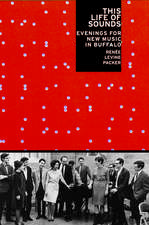Michael Nyman: Collected Writings
Autor Pwyll ap Siônen Limba Engleză Paperback – 11 noi 2016
| Toate formatele și edițiile | Preț | Express |
|---|---|---|
| Paperback (1) | 489.26 lei 6-8 săpt. | |
| Taylor & Francis – 11 noi 2016 | 489.26 lei 6-8 săpt. | |
| Hardback (1) | 1064.52 lei 6-8 săpt. | |
| Taylor & Francis – 28 iul 2013 | 1064.52 lei 6-8 săpt. |
Preț: 489.26 lei
Nou
Puncte Express: 734
Preț estimativ în valută:
93.65€ • 101.76$ • 78.72£
93.65€ • 101.76$ • 78.72£
Carte tipărită la comandă
Livrare economică 21 aprilie-05 mai
Preluare comenzi: 021 569.72.76
Specificații
ISBN-13: 9781138255869
ISBN-10: 1138255866
Pagini: 396
Dimensiuni: 156 x 234 x 21 mm
Greutate: 0.45 kg
Ediția:1
Editura: Taylor & Francis
Colecția Routledge
Locul publicării:Oxford, United Kingdom
ISBN-10: 1138255866
Pagini: 396
Dimensiuni: 156 x 234 x 21 mm
Greutate: 0.45 kg
Ediția:1
Editura: Taylor & Francis
Colecția Routledge
Locul publicării:Oxford, United Kingdom
Cuprins
Contents: Foreword, Michael Nyman; Preface; Introduction; Part I Reviews, Criticisms and Short Prose Writings: Section 1 1968-1969: Blocks of granite; The sound of music; Enter Birtwistle; New favourites; Shawms and rackets; Alexander Goehr’s Naboth’s Vineyard; Harrison Birtwistle’s Punch and Judy; Minimal music; Chaconnes; About time too; Now you see it, now you don’t; Is this a record?; Play group; Work projects; Demolition squad; French polish; Two new works by Birtwistle; Not being done; This way madness; Boulez in the labyrinth; Skip and run; Hands off; Patchwork; Mr Birtwistle is out; Purcell in his cups; Brass tacks; With reference to Birtwistle’s Medusa; Scratch and co; Drums and symbols. Section 2 1970-1971: Old master; Food of love; Six to one; Ancient monument; Flowerpot men; Stockhausen and David Bedford; Birtwistle’s rituals; Satiety; Anachronisms; Big screen opera; Sign language; Boulez’s law; Stockhausen - the musician, the machine; Interconnections; Stockhausen kommt; Panethnic; Steve Reich, Phil Glass; Stockhausen; Towards interpretation; Stravarese; Uncommercial; Melody rides again; Disciplinarians; Dart’s epitaph. Section 3 1972-1977: Learning from scratch; Causerie; Circle complete; Christian Wolff; The experimental tradition; As the Titanic went down; Last week’s broadcast music: Morton Feldman; Last week’s broadcast music: electronic music; Last week’s broadcast music: Robert Simpson; Last week’s broadcast music: Harrison Birtwistle; Last week’s broadcast music: Anton Bruckner; Americana; Tippett at 70; Peak district; Bare essentials; Mexican discovery; Lindbergh’s flight. Part II Articles, Essays, Interviews and Longer Prose Pieces: Towards (a definition of) experimental music; Tim Souster’s night out at the Proms; John Cage in Paris; Steve Reich: an interview with Michael Nyman; Harrison Birtwistle; Cornelius Cardew’s The Great Learning; SR - mysteries of the phase; Cage and Satie; Cage/Cardew; The experimental
Notă biografică
Pwyll ap Siôn is Senior Lecturer at the University of Bangor and the author of The Music of Michael Nyman: Texts, Contexts and Intertexts (Ashgate 2007). He is joint editor of the Ashgate Research Companion to Minimalist and Postminimalist Music (2013) and he regularly contributes reviews for The Gramophone magazine.
Recenzii
’ ... some of the best journalism of the time. One of the most attractive features of this collection of reviews and critical essays from the years between 1968 and 1982 is Nyman's unstuffy appreciation of all that he found authentic - Birtwistle and Maxwell Davies as much as Cardew or Reich. Nyman's writings offer a fresh and fascinating portrait of a musical world whose consequences remain salient today’. The Musical Times
Descriere
An important element in unlocking the key to Michael Nyman's success lies in his writings about music. Much of what transformed and defined his musical character may be found within the pages of this volume of his writings, comprehensively edited and annotated for the first time, and including previously unpublished material from Nyman's second interview with Steve Reich in 1976. There is also much here to engage those who are interested in pre-20th century music, from Early and Baroque music (Handel and Purcell in particular) to innovative features in Haydn, spatial elements in Berlioz, or Bruckner and Mahler's symphonic works.















